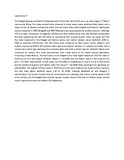Fault-related Soil Efflux of Mantle-derived CO2 in the Magadi and Natron Basins, East African Rift

View/
Date
2014Author
Lee, H
Muirhead, J
Fischer, T P
Kattenhorn, SA
Ebinger, C J
Thomas, N.
Kianji, G
Onguso, B
Maqway, MD
Language
enMetadata
Show full item recordAbstract
The Magadi (Kenya) and Natron (Tanzania) basins of the East African Rift are in an early stage (< 7 Ma) of continental rifting. The many normal faults observed in these areas create sediment-filled basins and a large number of alkaline springs feed water into two major lakes (Lake Magadi and Natron). Earthquake swarms reported in 1998 (Magadi) and 2007 (Natron) were accompanied by surface ruptures. Although CO2 is a major component of magmatic volatiles and fault-related fluids that may facilitate earthquakes and fault weakening, the soil CO2 efflux of continental rifts is poorly known. Here, we report soil CO2 flux rates measured in the Magadi and Natron basins, and carbon isotope values (delta13C, 0/00 vs. PDB) to constrain CO2sources. Soil CO2 fluxes were measured at fault zones, horsts, grabens, and surface ruptures by EGM-4 (PP systems) with a gas accumulation chamber. A t-shaped connector with a needle was used for gas sampling into evacuated glass vials with a rubber septum. delta13C values were measured by isotope ratio mass spectrometer with a gas bench at the stable isotope laboratory, University of New Mexico. The fault zones in the Magadi basin have higher maximum CO2 flux rates (< 533.52 g m-2 d-1) and heavier delta13C values (< -3.8 0/00) than the Natron basin (< 147.12 g m-2 d-1 and < -6.2 0/00, respectively). In both areas, soil CO2 efflux is insignificant (< 10 g m-2 d-1) in both horsts and the middle of grabens with lighter delta 13C values (~ -10 0/00) likely resulting from significant air contribution. The highest CO2 flux rates (< 919.44 g m-2 d-1) were measured at recent surface ruptures, but they have lighter delta13C values (-10 to -15 0/00), implying significant air and biogenic C contributions. Our results indicate that (1) normal faults are pathways that deliver mantle-derived CO2 to the surface, (2) the Magadi basin exhibits greater mantle-derived CO2 than the Natron basin, and (3) recent ruptures are zones of shallow CO2 degassing.
Citation
Lee, H., Muirhead, J., Fischer, T. P., Kattenhorn, S. A., Ebinger, C. J., Thomas, N., ... & Maqway, M. D. (2014, December). Fault-related Soil Efflux of Mantle-derived CO2 in the Magadi and Natron Basins, East African Rift. In AGU Fall Meeting Abstracts (Vol. 1, p. 4759).Publisher
University of Nairobi
